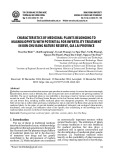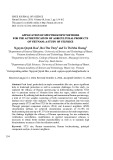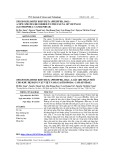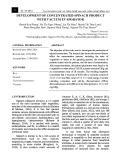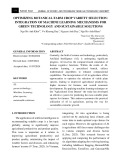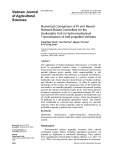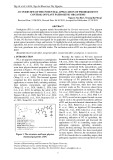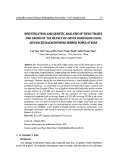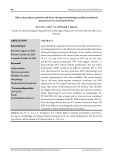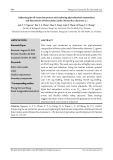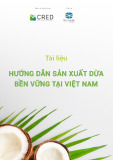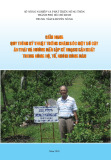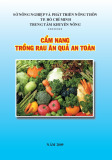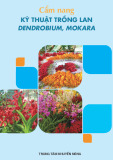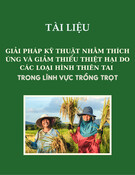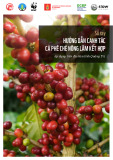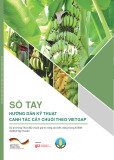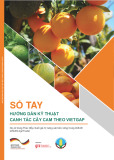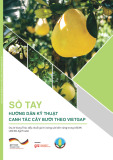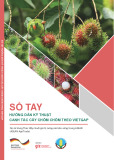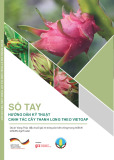
Nong Lam University, Ho Chi Minh City 19
The Journal of Agriculture and Development 23(Special issue 1) www.jad.hcmuaf.edu.vn
regime is also different. The growth and yield of
corn depend significantly on nutrient supply,
irrigation intensity, soil and environment.
Potassium is one of the essential
macronutrients for plants. Potassium is required
for the activity of enzymes, controlling stomatal
opening, enhancing resistance to pests, drought
and low temperatures. Potassium promotes
photosynthesis, transports photosynthetic
Effects of different potassium doses on yield and quality of two sweet corn hybrid combinations
(Zea mays var. saccharata) in Ho Chi Minh City
Phuong Nguyen1*, & Thanh D. Huynh1,2
1Faculty of Agronomy, Nong Lam University, Ho Chi Minh City, Vietnam
2Dong Nai - Kratie Rubber Development Company Limited in Cambodia, Kratie, Cambodia
ARTICLE INFO ABSTRACT
Research Paper
Received: July 12, 2024
Revised: September 19, 2024
Accepted: September 22, 2024
Keywords
Brix level
Fresh ear yield
Potassium fertilizer
Sweet corn hybrid combination
*Corresponding author
Nguyen Phuong
Email:
nguyenphuong@hcmuaf.edu.vn
The study aimed to determine the appropriate amount of
potassium for two newly selected sweet corn hybrid combinations
of the Department of Genetics and Plant Breeding, Nong Lam
University, Ho Chi Minh City. The experiment was conducted in
the winter-spring crop of 2023 - 2024 in Thu Duc, Ho Chi Minh
City with 4 potassium levels (70, 90, 110, and 130 kg K2O/ha)
and 2 combinations of sweet corn hybrids BN191, BN211 and
control variety (Golden Cob). The results showed that different
rates of potassium affected the yield, quality and resistance to pests
and diseases of sweet corn hybrid combinations. The potassium
dosage of 130 kg K2O/ha gave the highest fresh ear yield, low pests,
and infection rate and highest Brix for the two selected hybrid
combinations and the Golden Cob variety.
Cited as: Nguyen, P., & Huynh, T. D. (2024). Effects of different potassium doses on yield and quality
of two sweet corn hybrid combinations (Zea mays var. saccharata) in Ho Chi Minh City. The Journal
of Agriculture and Development 23(Special issue 1), 19-29.
1. Introduction
Besides selecting good varieties, determining
appropriate cultivation practices for the new
varieties is an important solution to maximize
the yield potential. Nguyen (2013) stated that
fertilizers contributed 40% to crop yield, varieties
contributed 30%, and plant protection products
contributed 20%. Each corn variety has different
growth characteristics and yield, so the fertilizer

20 Nong Lam University, Ho Chi Minh City
The Journal of Agriculture and Development 23(Special issue 1) www.jad.hcmuaf.edu.vn
of potassium (K1: 70 kg K2O/ha, K2: 90 kg K2O/ha
(control), K3: 110 kg K2O/ha, K4: 130 kg K2O/ha)
and the main plot factor included 2 hybrid sweet
corn varieties and the Golden Cob variety (G1:
BN191, G2: BN211, G3: Golden Cob (control).
The total number of base plots was 36; base plot
area: 2.8 m × 5 m = 14 m2; planting distance: 70
cm × 25 cm; total experimental area: 600 m2.
Amount of fertilizer (kg/ha): The amounts of
nitrogen, phosphorus, and cow manure are the
same across the treatments, specifically: 150 kg
N - 80 kg P2O5 and 10 tons of decomposed cow
manure. Urea (46% N) and DAP (18% N - 46%
P2O5) were used. Amount of potassium: applied
according to each experimental treatment. KCl
(61% K2O) was used.
Fertilization method: All cow manure and
phosphorus fertilizer and 1/4 of urea were
applied together at the time of sowing. There
were 4 top dressing fertilizer applications in
which the first application used 1/4 urea at 10 -
15 days after sowing (when the plant had 3 - 4
leaves), the second application used 1/4 urea +
1/3 potassium at 25 - 30 days after sowing (when
the plant had 7 - 8 leaves), the third application
used 1/4 urea + 1/3 potassium at 40 - 45 days
after sowing (when the plant had 10 - 11 leaves),
and the fourth application used 1/3 potassium
at 50 - 55 days after sowing (when the plant had
over 11 leaves).
The experiment was conducted during the
winter-spring 2023 - 2024 season at the research
station of the Faculty of Agronomy, Nong Lam
University, Ho Chi Minh City on sandy soil
(sand:silt:clay ratio of 62:28:10), slightly acidic
soil (with pH values of 6.5 and 5.3 for H2O and
KCl, respectively); low organic matter content in
the soil (1.7%); poor in total nitrogen and total
potassium.
products to accumulate in seeds. Potassium is
necessary as an activator for over 60 enzymes
in the meristematic tissue. The important factor
in cell division is the effect of potassium on the
extension of cells. With sufficient potassium, cell
walls are thicker and cell tissue is more stable.
Because of this effect, cells grow normally,
strengthen resistance and resist pests (Beringer
& Nothdurft, 1985). Based on this reality,
determining the appropriate dose of potassium
helps inhance productivity, quality and pest
resistance for the two newly selected sweet corn
hybrids BN191 and BN211.
2. Materials and Methods
2.1. Materials
The materials studied include two hybrid
sweet corn varieties (BN191, BN211) researched
and hybridized at the Department of Genetic
and Plant Breeding, Nong Lam University of Ho
Chi Minh City, with the control variety Golden
Cob (which is the most commonly grown in
Vietnam. This variety is imported from Thailand
and distributed by East - West Seed Company.
The Golden Cob sweet corn has a short growth
period of 68 to 72 days, an average plant height,
and an average weight of 490 to 520 g per ear.
The kernels are aligned, bright yellow, and have
a soft and sweet taste and chloride Potassium
fertilizer (Phu My potassium: 61% K2O)
from Petrovietnam Fertilizer and Chemicals
Corporation.
2.2. Methods
2.2.1. Field experiment set up
The experiment involved two factors arranged
in a split-plot design with 12 treatments, 3
replications. The subplot factor included 4 levels

Nong Lam University, Ho Chi Minh City 21
The Journal of Agriculture and Development 23(Special issue 1) www.jad.hcmuaf.edu.vn
S (dm2) = Σ (D × R × 0.7).
Fresh ear yield (tons/ha): FY = (EW × 10-3)/
(So × 10-4). Where: EW is the weight (kg) of fresh
ears in the middle of 2 rows; So is the area of the
middle of 2 rows (m2).
2.2.3. Methods for statistical data processing
The collected data were statistically processed
using SAS 9.1 software.
3. Results and Discussion
3.1. Growth parameters
2.2.2. Criteria and monitoring methods
Monitoring criteria include agronomic
traits, pest damage status, yield parameters and
quality of sweet corn varieties. The monitoring
criteria and data collection methods comply with
the National Standards for Agricultural Crop
Varieties - Experimental value of cultivation and
utilization of corn varieties (TCVN, 2021).
Leaf area (dm2) measured once at the
tasseling stage (50 days after sowing). Leaf length
(dm) measured from the leaf collar to the leaf tip,
leaf width (dm) measured at the widest point of
the leaf Blade, measuring all green leaves on the
plant. Leaf area (S) calculated using the formula:
Table 1. Effect of potassium dose on tasseling, silking and harvesting stage of sweet corn hybrid
combinations
Agronomic
Trait
Potassium levels (kg
K2O/ha) (B)
Hybrid combinations (A) Mean B
BN191 BN211 Golden Cob
Days to tassel
(DAS)
70 47.0 48.7 48.0 47.9
90 47.0 48.7 47.3 47.7
110 46.7 48.3 47.3 47.4
130 47.3 48.7 48.3 48.1
Mean A 47.0b48.6a47.8ab
CV (%) = 1.3 FA = 19.83** FB = 1.95ns FAB= 0.41ns
Days to silking
(DAS)
70 50.3 51.7 52.7 51.6
90 51.0 52.3 52.3 51.9
110 50.3 52.3 52.7 51.8
130 50.7 51.7 53.0 51.8
Mean A 50.6b52.0a52.7a
CV (%) = 1.0 FA = 50.59** FB = 0.66ns FAB= 1.48ns
Day to harvest
(DAS)
70 68.3 68.3 71.3 69.3
90 68.3 68.7 71.0 69.3
110 68.7 68.3 71.7 69.6
130 68.3 68.7 72.0 69.7
Mean A 68.4b68.5b71.5a
CV (%) = 0.8 FA = 111.08** FB = 0.75ns FAB= 0.75ns
In the same group of mean values, numbers with the same accompanying characters indicate statistically in-
significant differences; ns: no difference; **: significant difference at the level of α = 0.01; DAS: days after sowing.

22 Nong Lam University, Ho Chi Minh City
The Journal of Agriculture and Development 23(Special issue 1) www.jad.hcmuaf.edu.vn
3.2. Plant parameters
Table 2 showed that: Plant heights ranging
from 214.7 to 228.8 cm. Plant height tended to
increase proportionally with potassium doses,
with the lowest plant height at 70 kg K2O/ha
and the highest at 130 kg K2O/ha. However, this
influence on plant height was not significantly
different; the differences are not statistically
meaningful. The average plant heights of different
varieties was not significantly different.
Varieties with low ear-setting height
show good resistance to lodging and high
mechanization capabilities, but affect the
pollination process and are easily damaged by
pests and diseases (Tran, 2004). The results in
Table 2 showed significant differences in ear-
setting height among experimental corn varieties,
with the BN211 hybrid reaching the tallest ear-
setting height at 109.2 cm and the Golden Cob
variety having the shortest ear-setting height
(85.3 cm). The potassium dosage did not affect
the ear-setting height of the experimental hybrid
combinations and the differences in ear-setting
height among experimental treatments are not
statistically significant.
The data evaluation results in Table 1
showed that the flowering and pollen shedding
stage occurs in a relatively short period but is a
crucial period for determining the productivity
of corn plants as it affects the fertilization
process, determining the number of seeds
on the ear. During this stage, nutrients from
the stemp and leaves directed towards to the
reproductive organs and organic compounds
start accumulating towards to the seeds (Tran,
2004). The experimental results showed that in
the winter-spring crop of 2023-2024, the varieties
affected the growth period of sweet corn; There
were significant statistical differences in days
to tasseling, silking and harvesting among the
experimental hybrid combinations; different
levels of potassium did not affect the growth
period of the experimental hybrid combinations.
The days to tassel of the hybrid combinations
ranged from 46.7 to 48.7 days after sowing (DAS),
the days to silking time ranged from 50.3 to 53
DAS and the fresh ear harvesting time ranged
from 68.3 to 72 DAS. Hybrid combination,
BN191, has an earlier flowering, pollen shedding
and harvesting time than hybrid combinations
BN211 and Golden Cob variety.

Nong Lam University, Ho Chi Minh City 23
The Journal of Agriculture and Development 23(Special issue 1) www.jad.hcmuaf.edu.vn
Table 2. Effect of potassium doses on plant characteristics of sweet corn hybrid combinations
Agronomic
Trait
Potassium levels (kg
K2O/ha) (B)
Hybrid combinations (A) Mean B
BN191 BN211 Golden Cob
Plant height
(cm)
70 214.7 228.8 222.0 221.8
90 226.4 221.9 219.9 222.7
110 221.5 225.4 222.3 223.1
130 221.1 227.3 221.8 223.4
Mean A 220.9 225.8 221.5
CV (%) = 3.5 FA= 1.44ns FB= 0.07ns FAB= 0.80ns
Ear-setting
height (cm)
70 88.2 108.5 85.3 94.0
90 93.8 110.5 85.1 96.5
110 89.5 107.2 86.1 94.3
130 92.6 110.5 84.8 96.0
Mean A 91.0 109.2 85.3
CV (%) = 5.5 FA = 67.81** FB = 0.50ns FAB = 0.29ns
Plant
diameter
(cm)
70 2.9 2.7 2.7 2.8
90 2.7 3.1 3.0 2.9
110 2.7 3.0 2.9 2.9
130 3.1 3.1 3.1 3.1
Mean A 2.8 2.9 2.9
CV (%) = 9.9 FA = 0.37ns FB = 1.61ns FAB = 0.65ns
In the same group of mean values, numbers with the same symbol indicate a non-statistically significant
difference; ns: no statistically significant difference; **: difference at a significance level of α = 0.01.
stem diameter of 2.8 cm at a potassium dose of
70 kg K2O/ha. and the largest stem diameter of
3.1 cm at a potassium dose of 130 kg K2O/ha.
3.3. Leaf morphology traits
Table 3 showed that the number of leaves
per plant ranged from 17.5 to 18.4. In overall,
which is consistent with previous studies by the
author Tran (1993); 2 hybrid combinations and
the check variety had similar leaf numbers in
the experiment, which also matched the similar
growth periods of these varieties.
The stem diameter reflects the growth status
of the plant and was directly relate to the plant’s
ability to resist falling. The large stem diameter
indicates good growth, nutrient absorption, root
development and high resistance to falling for
corn plants, whereas the small stem diameter
indicates the opposite. In the winter-spring crop
of 2023 - 2024, experimental hybrid combinations
had stem diameters that ranged from 2.7 - 3.1 cm.
with no differences in stem diameter between
two hybrid combinations and the Golden Cob
variety. Stem diameter tended to increase with
increasing levels of potassium. with the smallest

